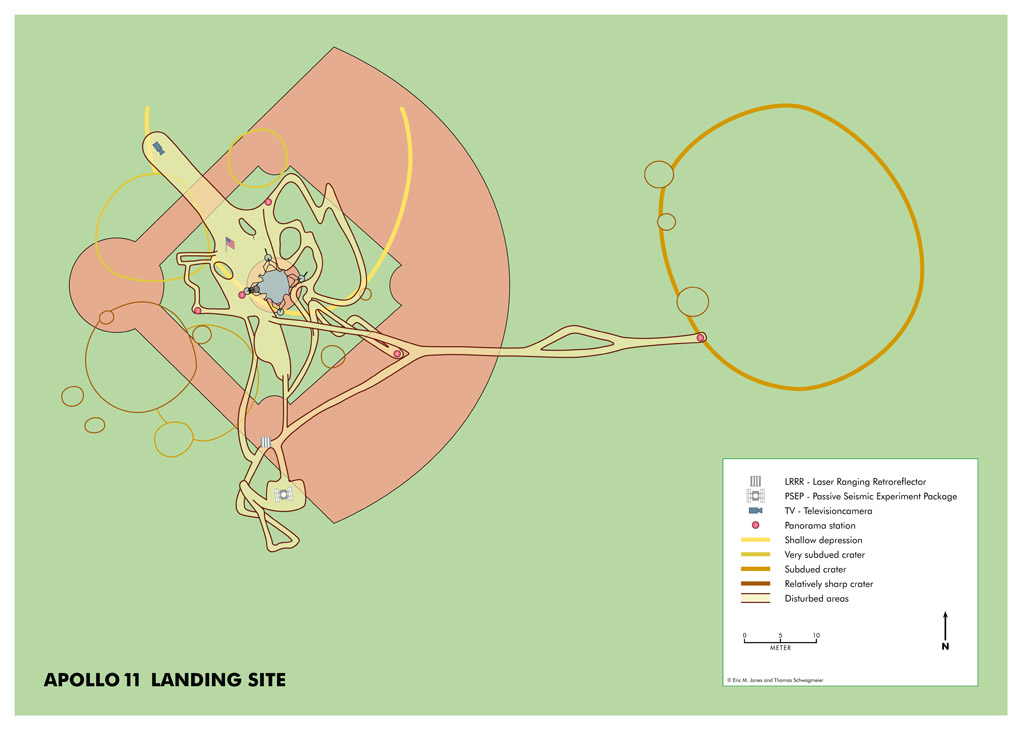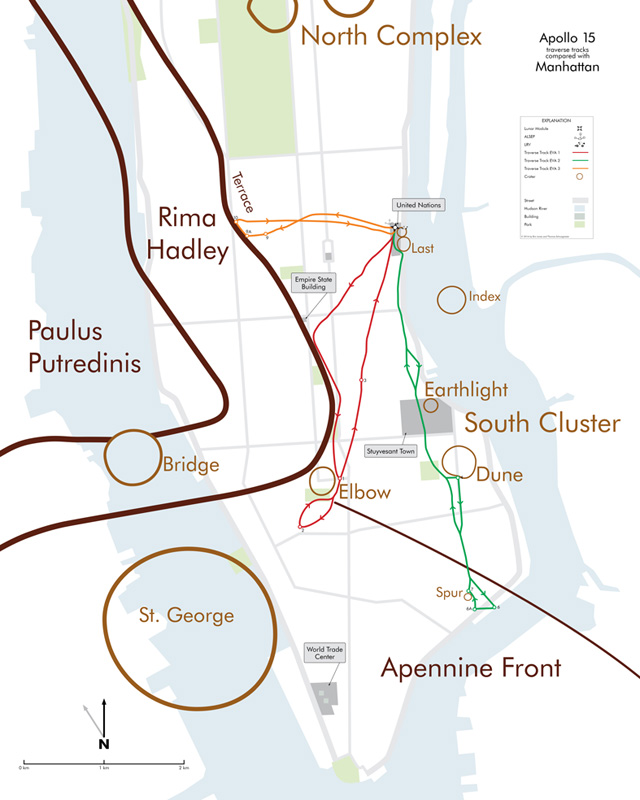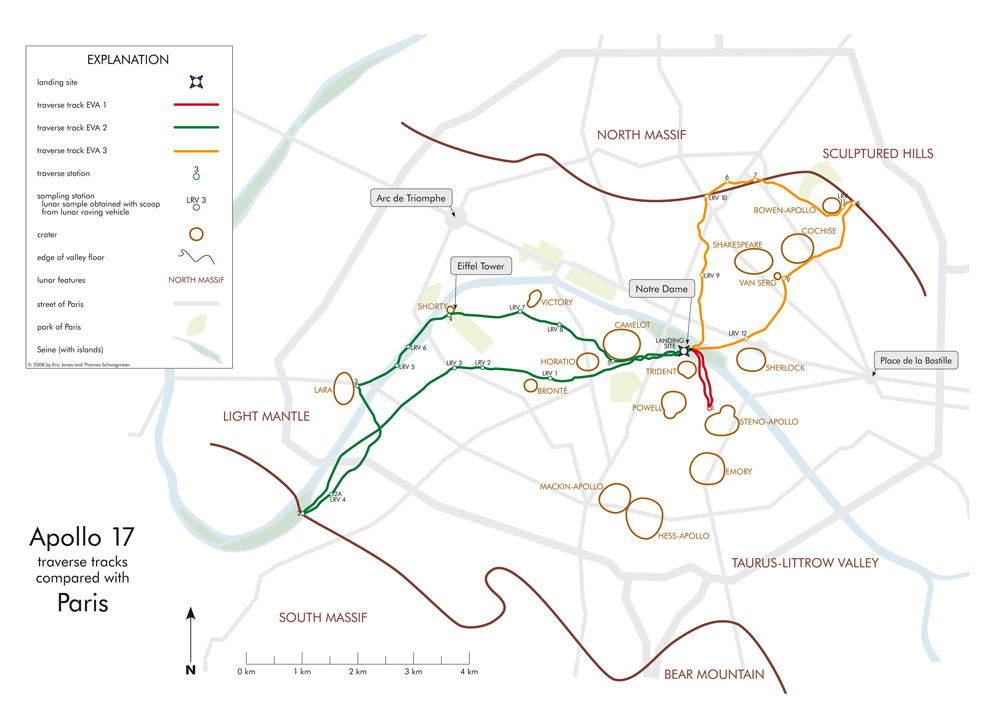
Apollo Traverse Maps Superimposed on Terrestrial Sites
Copyright 2012-15 byThomas
Schwagmeier and Eric M. Jones.
All rights reserved.
Last revised 4 January 2015.

| Lunar nearside map with
the Apollo landing sites marked. |
The Moon is a big place. The nearside has
a surface area (19 million square kilometers) about twice that
of the United States (9.8 million sq km). The Apollo
landing sites are all on the nearside in an area from lunar
longitiude of 23.4 W (Apollo 12) to 30.8 E (Apollo 17) and
lunar latitude from 9.0 S (Apollo 16) to 26.1 N (Apollo
15). The area within that box is about 1.7 million square
kilometers.
An area of similar size in the United States includes portions of New Mexico, Colorado, Kansas, Oklahoma, Texas, Louisiana, Arkansas, and Missouri. The following composite map shows the distribution of Apollo Landing Sites on a Google Earth map of that area.
An area of similar size in the United States includes portions of New Mexico, Colorado, Kansas, Oklahoma, Texas, Louisiana, Arkansas, and Missouri. The following composite map shows the distribution of Apollo Landing Sites on a Google Earth map of that area.
| Note the 600-km scale at
the lower left of the US map detail. The
superimposed locations range from Apollo 12 in far
southwestern New Mexico; Apollo 14 near El Paso; Apollo
16 near Houston; Apollo 11 in southerwestern Arkansas;
Apollo 17 near St. Louis; to Apollo 15 in Furnas County,
Nebraska. Surrounding the central map (click on
the image for a full version) are Google Moon details
showing the traverses at each of the sites. A
scale is provided at the lower left in each
detail. For the Apollo 15, 16, and 17 details, the
scale is 8 km, just over one percent of the scale on the
US detail. The Apollo 11, 12, and 14 scales are
much smaller. Collectively, these maps
demonstrate how widely spread the sites were and how
little of the Moon was actually visited by the LM crews. |
Apollo 11:
Baseball and Football (Soccer) Comparisons
On this first landing mission, NASA planned a
brief, conservative, 2-1/2-hr EVA, with the crew staying close
to the LM at all times. No one wanted to take on any unnecessary
risks.


| The traverses in the
Baseball and Soccer comparisons are based on
high-resolution photos from the Lunar Reconnaissance
Orbiter Camera. The location where Armstrong took
a panorama on the rim of Little West Crater is derived
from a 2012
photogrammetric analysis. With thanks to Joe O'Dea
for suggesting the soccer comparison. |
After Armstrong and Aldrin showed that moving
around on the lunar surface was not difficult, the other five
crews who landed on the Moon ventured much farther from their
LMs. The illustrations that follow show the various
traverse maps superimposed on simplified maps of terrestrial
locations, providing another way to judge how large an area each
of the crews explored.
Apollo 12 in Rome

| The Apollo 12 traverse
map superimposed on a simplified map of Rome. Note
that Surveyor Crater is slightly larger than the
Coliseum. (Click on the image for a larger version.) |
Apollo 12 at the Vatican

| The Apollo 12 traverse map superimposed on a simplified map of the Vatican. (Click on the image for a larger version.) |
Apollo 14 visits Washington, D.C.

| Apollo 14 - Washington
D.C. comparison with the LM at the Lincoln Memorial and
the center of Cone Crater on E street between the South
Lawn of the White House and the Ellipse. The inset
at the bottom shows elevation above the LM along the
traverse path. At Station C near the rim of
Cone, Shepard and Mitchell were about 90 meters above
the LM. There are no significant elevation differences
along the D.C. route. (Click on the image for a
larger version.) |
The last three crews each took a Lunar Roving
Vehicle to the Moon, giving them far more mobility and allowing
them to carry much more equipment and samples.
Apollo 15 Takes Manhattan

Apollo 16 visits Sydney

Apollo 17 in Paris

| Apollo 17 traverse of
Paris, with the LM at Notre Dame, Station 2 on the Île
St. Germain near the monument dedicated to artist Jean
Dubuffet, and Station 4 at the Eiffel Tower.
(Click on the image for a larger version.) |
